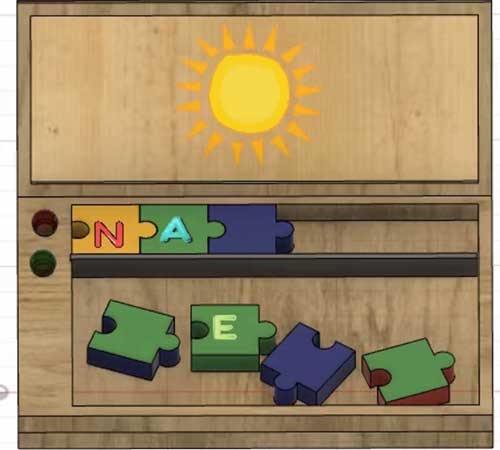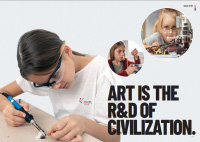Assignment for this week: Propose a final project masterpiece that integrates the range of units covered, answering:
What will it do?
Who’s done what beforehand?
What will you design?
What materials and components will be used?
Where will come from?
How much will they cost?
What parts and systems will be made?
What processes will be used?
What questions need to be answered?
How will it be evaluated?
– Your project should incorporate 2D and 3D design, additive and subtractive fabrication processes, electronics design and production, embedded microcontroller interfacing and programming, system integration and packaging
– Where possible, you should make rather than buy the parts of your project
– Projects can be separate or joint, but need to show individual mastery of the skills, and be independently operable.
-
- IntroductionFor my final project I want to design and make a word-puzzle for kids with different kinds of disabilities such as dyslexia or dysgraphia. It will be a wooden box with puzzle blocks in it. Each block will have a letter on it. I did the design for it on my Computer-aided design week

- What will it do?Imagine you have a box with different letter-blocks. Each block with a specific letter has a different color sticker on the bottom side. On the bottom of the box there is a board with color sensors. The teacher or instructor types a word in the computer program or mobile interface and it goes to the board. Kid has the same word or the picture associated with that word in front of him/her. Now kid has to put and connect blocks to have the same word. When (s)he puts the block, the color sensor reads the color on the block, checks if it’s the proper one, the green light on the block goes on. If the block is in the wrong place, the red light goes on. This way kids can develop their spelling and writing skills as well as motor skills.
- Who’s done what beforehand?When I checked previous final projects, I found this one done by MAY EL-DARDIRY which is similar to the one that I want to do. I found one simple analog in Aliexpress and the Tiblo project, which is very nice and intereting one.
- What will you design? I will design the following things:
- The frame box
- Puzzle blocks which should be 3D printed
- PCB board
- What materials and components will be used?
- Plywood for the box
- PLA to 3D print the blocks
- Fr1 to mill the PCB.
- Vinyl sheet to cut the letters
- Where will come from?I will be using the standard materials and components, which are available in the lab.
- How much will they cost?As I will not be using fancy materials and will make everything that is possible to make in the lab, I believe this project will not extend the maximum of $100. It’s hard to do calculations for price now, because I’m away from the lab and don’t have the final list of materials. Here I have tried to put some parts which are clear so far and will update this part later during the course.
-
- 5 VEML6040A3OG color sensor – $11
- 0.5 sheet of 150x150x10mm polished plywood – 6$
- Wires – $8
- 5 ATtiny44 microcontrollers – $5
- Resistors and capacitors – $2
- 1 FR1 PCB board – 2$
- 100g filament for 3D printing– $10
Total $44
-
- What parts and systems will be made? What processes will be used?
- The frame box will be machined with shopbot (Subtractive).
- Puzzle blocks will be 3D printed Makerbot (Additive).
- Letter – stickers will be vinyl – cutted using Roland GS-24
- PCB design KiCad (electronics design and production).
- PCBs will be milled SRM20 (Substractive).
- ATtiny44 or ATtiny45 will be programmed using c code avrdude and gcc (embedded microcontroller interfacing and programming).
- What questions need to be answered?I have to answer following questions:
- How will it be programmed?
- How to differentiate as many letters as possible to have many possible words?
- How many letters should be in the word as maximum?
- Where and with whom I can test it?
- Will it be user-friendly?
- How will it be evaluated?I believe this project will be evaluated as in a way described in Fab Academy Assessment handbook and has to fulfill following requirements:
- To what extent it includes all of the skills gained and developed during the Fab Academy cycle
- Is it affordable (less than $100) and is it easy to remake or make a new one of it?
- Are all of the parts fabricated or some of them were bought instead of fabricating?
- Is the process well documented and presented?
- And finally… Does it work?
Category:
AlumniDate:
February 3, 2022


